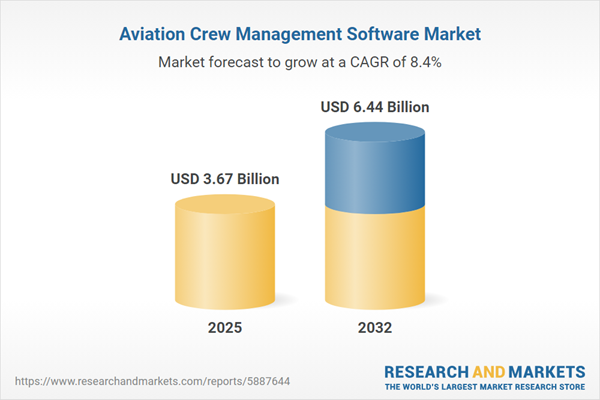Speak directly to the analyst to clarify any post sales queries you may have.
Aviation crew management software is reshaping how airlines and operators manage their workforce, streamline compliance, and drive operational agility. Senior leaders are leveraging these platforms to modernize crew processes and build resilience across highly regulated environments.
Market Snapshot: Aviation Crew Management Software Market
The Aviation Crew Management Software Market is experiencing robust growth, with expansion from USD 3.38 billion in 2024 to USD 3.67 billion in 2025 and a compound annual growth rate of 8.36% projected to take the market to USD 6.44 billion by 2032. Market momentum is fueled by rising demands for regulatory compliance, optimization of operations, and the adoption of real-time scheduling technologies. Airlines and aviation operators are directing investments toward digital platforms that enhance productivity, coordination, and adaptability as the sector evolves in response to industry dynamics and regulatory pressures.
Scope & Segmentation of Aviation Crew Management Software
This report delivers a comprehensive analysis by segmenting aviation crew management software according to organizational needs, regional landscapes, and compliance complexity. The market’s evolving structure reflects varying technology uptake and workflow requirements within the aviation industry.
- Component: Consulting, support, maintenance, and technology platforms drive the facilitation of robust scheduling, efficient crew management, and seamless tracking.
- Deployment Mode: Cloud-based and on-premise options, including hybrid, private, public, client-server, and web-based models, allow scalability and address collaboration and security expectations.
- System Type: Qualification management, both automated and manual scheduling, as well as GPS or RFID-based tracking systems, are central to streamlined compliance and effective workforce allocation.
- Crew Type: Modules are designed to meet the specific workflow and regulatory requirements of cabin, flight, and ground personnel, supporting end-to-end continuity and adherence.
- End User: Various stakeholders such as commercial airlines, cargo providers, military, and defense organizations access tailored workflow and reporting capabilities via these solutions.
- Application: Predictive analytics, performance monitoring, integrated planning, scheduling, and training using simulation tools extend operational readiness and enable proactive management.
- Region: Coverage includes the Americas, EMEA, and Asia-Pacific, addressing digital maturity, local regulatory conditions, and differences in infrastructure.
- Companies Analyzed: The study benchmarks leaders such as Sabre Corporation, The Boeing Company, Amadeus IT Group S.A.S, IBS Software Services Limited, Lufthansa Systems GmbH & Co. KG, Airbus SAS, Ramco Systems Limited, Merlot Aero Ltd, Swiss AviationSoftware Ltd, and AIMS International Ltd.
Key Takeaways for Senior Decision-Makers
- Integrated digital platforms simplify processes, improving scheduling, resource allocation, and qualification oversight to increase operational efficiency.
- Advanced analytics powered by artificial intelligence enhance decision-making, driving more proactive responses to staff well-being, scheduling challenges, and changing regulatory frameworks.
- Cloud architecture offers rapid scalability and supports real-time collaboration, which is particularly valuable for organizations operating across multiple locations and regions.
- Technologies like GPS and RFID increase the visibility of crew actions, helping improve both safety procedures and responsiveness during operations.
- Strategic partnerships, integration with related services, and targeted acquisitions enable vendors to create solutions that address specialized needs within the aviation ecosystem.
- Diverse regulatory environments and varying IT infrastructures require tailored approaches to implementation and adoption, especially among operators active in different jurisdictions.
Tariff Impact: Navigating Complexities in Procurement and Deployment
Tariff structures on aviation software, hardware, and related services necessitate adaptive procurement strategies. Many airlines are increasing reliance on regional technology providers and embracing local cloud hosting and modular contract agreements. These measures strengthen cost-control capabilities and bolster operational reliability even as market demands and compliance requirements continue to shift.
Methodology & Data Sources
Data supporting this analysis is derived from direct interviews with industry executives, in-depth reviews of sector reports, regulatory evaluations, and company briefings. Methodological rigor is maintained through triangulation, cross-validation, and advanced quantitative analysis, encompassing perspectives from regulators, airlines, and technology suppliers.
Why This Report Matters
- Benchmark your organization’s position against leading global players to track progress in aviation crew management software adoption and migration to digital platforms.
- Identify prevailing technology, procurement, and service approaches that influence compliance and resilience across diverse operational and regulatory contexts.
- Support investment strategies and manage risk through independent, data-driven competitive analysis relevant to the current and future aviation sector landscape.
Conclusion
Aviation crew management software enables organizations to enhance reliability, strengthen workforce management, and better align with industry changes. Digital adoption ensures ongoing efficiency and supports evolving organizational objectives in the aviation sector.
Additional Product Information:
- Purchase of this report includes 1 year online access with quarterly updates.
- This report can be updated on request. Please contact our Customer Experience team using the Ask a Question widget on our website.
Table of Contents
3. Executive Summary
4. Market Overview
7. Cumulative Impact of Artificial Intelligence 2025
Samples

LOADING...
Companies Mentioned
The key companies profiled in this Aviation Crew Management Software market report include:- Sabre Corporation
- The Boeing Company
- Amadeus IT Group S.A.S
- IBS Software Services Limited
- Lufthansa Systems GmbH & Co. KG
- Airbus SAS
- Ramco Systems Limited
- Merlot Aero Ltd
- Swiss AviationSoftware Ltd
- AIMS International Ltd
Table Information
| Report Attribute | Details |
|---|---|
| No. of Pages | 187 |
| Published | October 2025 |
| Forecast Period | 2025 - 2032 |
| Estimated Market Value ( USD | $ 3.67 Billion |
| Forecasted Market Value ( USD | $ 6.44 Billion |
| Compound Annual Growth Rate | 8.3% |
| Regions Covered | Global |
| No. of Companies Mentioned | 11 |









